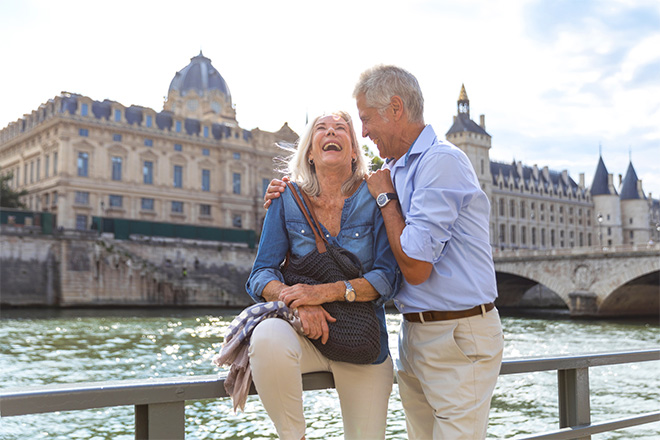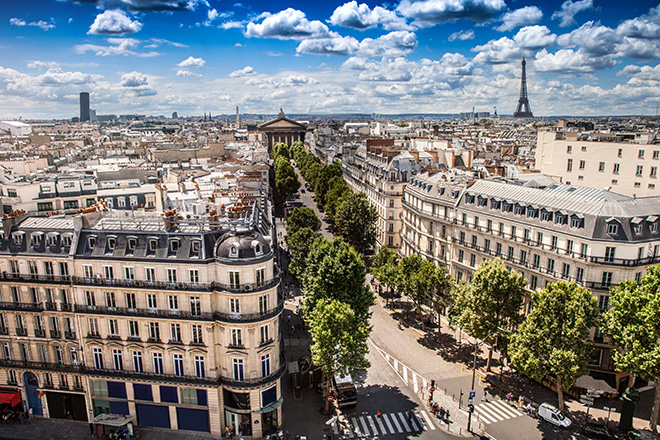Understanding the Swirl of Paris Neighborhoods
Imagine the swirl of the shell
of those delicious little escargots you find on the menus of so many Parisian
bistros. You'll notice that those shells spiral out in a clockwise direction
from the center. Paris neighborhoods are arranged in a similar fashion,
starting with the 1st arrondissement and spiraling outwards to the 20th. The
arrondissements are surrounded by the ring road of the périphérique and beyond
lie the suburbs of Paris, known as the banlieues. Each of these Paris
neighborhoods has something special to offer, so we'll take you through the
highlights here.

Arrondissements 1 and 2: Louvre and Bourse
Located right in the center of
the city, Louvre is one of the grandest of Paris neighborhoods but also the
least populated. Instead of residential areas, it has some of the city's
best-known sights, such as the Louvre and Royal Palace. Just to northeast,
Bourse is the smallest arrondissement, but one of the city's foremost business
districts. It's home to the former stock exchange, the Palais de la Bourse, and
the National Library. Both areas are extremely well policed and are among the
safest neighborhoods in Paris.
Arrondissements 3 and 4: Temple and Hôtel-de-Ville
Temple encompasses the northern part of the historic Marais district. Its narrow cobbled streets offer a view of the medieval city and with an abundance of little boutiques, galleries, and bars, it's one of the trendiest neighborhoods in Paris. Temple is also great for culture, with the Conservatoire National des Arts et Métiers, the Picasso Museum, and the Carnavalet Museum. Hôtel-de-Ville contains the southern part of the Marais and the eastern section of Île de la Cité, the oldest quarter of the city. It's home to the Notre-Dame Cathedral and Centre Pompidou.

Arrondissements 5 and 6: Pantheon and Luxembourg
Situated on the famous Left Bank, or Rive Gauche, Pantheon is where you'll find the Latin Quarter and famous Sorbonne university. You can wander a maze of narrow streets and alleys, brimming with bookshops and bistros. For Bohemian Parisians, this has long been regarded as one of the coolest neighborhoods in Paris. Immediately to the west, Luxembourg provides the perfect opportunity to escape the bustle of the city. The Jardin du Luxembourg is one of the world's great parks and is a must for a relaxing stroll, while the Odéon Theatre, Saint Sulpice church, and the 11th century abbey of Saint-Germain des Prés provide other diverting attractions.
Arrondissements 7 and 8: Palais-Bourbon and Élysée
These are undoubtedly two of the best neighborhoods in Paris for sightseeing. Palais-Bourbon is just to the west of Luxembourg and is home to the Eiffel Tower, one of the most famous landmarks in the world and a Paris icon that draws millions of tourists. It's also a magnet for lovers of history and culture, with the Invalides, Napoleon's tomb, Musée d'Orsay, Musée Rodin, and the Musée du Quai Branly. Cross the Seine and you will find Élysée, with one world's greatest boulevards, the Champs-Élysées, along with the Place de la Concorde, Arc de Triomphe, Grand Palais, Petit Palais, the presidential Palace, Madeleine church, and the achingly romantic Monceau Park.
Arrondissements 9 and 10: Opéra and Enclos-St-Laurent
Opéra is one of the most diverse Paris neighborhoods, with magnificent boulevards, upscale restaurants and designer shopping in the south and the red light Pigalle area (thought by some to be one of the Paris neighborhoods to avoid) to its north. In the south is the former Opéra Garnier, a magnificent opera house, and the Galeries Lafayette, a renowned department store. The imposing Sainte-Trinité church is also to be found here. Enclos-St-Laurent will be familiar to you if you arrive in Paris by train, as the Gare de l'Est and Gare du Nord are found here. You can also go for a romantic walk along the Canal Saint-Martin and visit Saint-Vincent-de-Paul church.
Arrondissements 11 and 12: Popincourt and Reuilly
Popincourt is one of the more low profile Paris neighborhoods but a popular residential area. Oberkampf in the north is known for its nightlife and the spectacular shows at Cirque d'Hiver (the winter circus) inspired artists such as Henri de Toulouse-Lautrec and Georges Seurat. Reuilly is home to the impressive Bastille Opera and is also a popular residential area. It hosts the Bercy Stadium and the modern Bercy Park and is bordered on its eastern side by the massive Bois de Vincennes, Paris' biggest park.
Arrondissements 13 and 14: Gobelins and Observatoire
Another of the largely residential Paris neighborhoods, Gobelins is home to the impressive modern building of the National Library. It also houses the Hôpital de la Pitié-Salpêtrière, a sprawling 17th century hospital complex with an impressive chapel. This is also where you'll find the largest Chinatown in Paris. Observatoire takes its name from the the observatory of Paris and is one of the more lively Paris neighborhoods. There's some great nightlife to be found around Montparnasse Boulevard, and many famous French citizens are buried in Montparnasse Cemetery. Another popular tourist attraction in Observatoire are the catacombs, an former quarry that was turned into an underground tomb due to overcrowded cemeteries in the late 18th century.
Arrondissements 15 and 16: Vaugirard and Passy
Vaugirard is the largest of Paris neighborhoods both by size and population. It also boasts the soaring Tour Maine Montparnasse, the tallest skyscraper in the city center. The Parc André Citroën in the west of the arrondissement, meanwhile, is one of the most interesting modern parks in Paris. Passy is definitely one of the rich neighborhoods in Paris. It is bordered by the huge Boulogne park to the west, and its handsome boulevards attract some of the wealthiest Parisians. Palais de Chaillot offers superb views across the Seine to the Eiffel Tower and also houses some notable museums, including Musée Guimet, the Palais de Tokyo and Musée Marmottan.

Arrondissements 17 and 18: Batignolles-Monceau and Butte-Montmartre
Batignolles-Monceau is another of the more diverse Paris neighborhoods, with some grand boulevards in the south and the red light Pigalle neighborhood in the north. In the west, you'll find the huge Palais des Congrès complex, a large convention center with adjoining hotels. Butte-Montmartre is home to one of the most famous Paris neighborhoods, Montmartre. On a hill with fabulous views across the city, it's famous for its street artists, the Basilica of Sacré-Coeur, and the Place du Tertre. It's also where you'll find the Moulin Rouge, with its world famous can-can dancers and extravagant cabaret shows.
Arrondissements 19 and 20: Buttes-Chaumont and Ménilmontant
One of the lower-key Paris neighborhoods, Buttes-Chaumont still contains two of the city's most interesting parks, the Parc des Buttes-Chaumont and the modern Parc de la Villette, which houses the city's popular science museum. Ménilmontant, meanwhile, is a mostly residential neighborhood with a cosmopolitan character. It's also home to the most famous cemetery in Paris, the Cimetière du Père-Lachaise. Visitors come to see the graves of people such as Balzac, Gertrude Stein, Oscar Wilde, Bizet, Chopin, Rossini, Maria Callas, Edith Piaf, Isadora Duncan, Jim Morrison, Pissarro, Modigliani, Delacroix, Sarah Bernhardt, and Yves Montand.
The Best Neighborhoods for Shopping
As we can see from the overview of Paris neighborhoods above, each of the arrondissements has its own unique features and atmosphere to attract tourists. That said, there are undoubtedly some areas that excel in certain ways. Shopping in Paris is one of the main attractions for visitors, especially those looking to add to their wardrobe by profiting from the capital of fashion. Paris is home to some of the world's most famous designers, with haute couture houses such as Chanel, Dior, Givenchy, and Gaultier all based in the city.
Louvre and Tuileries (1st arr.) is one of the best Paris neighborhoods for the crème de la crème of Parisian designer fashion, especially around the Faubourg Saint-Honoré district. Boulevard Haussmann (8th and 9th arr.), meanwhile, is where to go for the breathtaking Belle Epoque department stores such as Galeries Lafayette and Printemps. The Marais (3rd and 4th arr.) is renowned for its independent boutiques, offering high-end and sometimes quite alternative fashions. Avenue Montaigne (8th arr.) and Avenue des Champs-Elysées rivals Saint Honoré for chic fashions, with legendary designers such as Chanel, Dior, and Louis Vuitton lining the streets alongside hip chains like Zara.
St-Germain-des-Prés (6th arr.) is one of the Paris neighborhoods renowned for classic design and is popular with young, upwardly mobile Parisians. Paco Rabanne and Sonia Rykiel are two of the popular boutiques here and the area is also known for its vintage stores. The Bon Marché department store is also one of the most renowned fashion stores for classic chic on the Left Bank. Les Halles and Rue de Rivoli (1st arr.) is popular with those seeking trendy boutiques and some of the major chain stores, while the Saint-Ouen flea market (18th arr.) in the north of the city is largest flea market in Paris and great for finding vintage fashion.
The Best Neighborhoods for Dining
Where to eat in Paris? Ah, that is the question. In a city famous for its food, the choice is huge and sometimes overwhelming. Where is best depends upon your own tastes, dietary requirements and budget but here we will try to outline the sort of dining options to be found in some of Paris neighborhoods most popular with the foodies. On the Left Bank, the area around Place Saint-Michel in the Latin Quarter (5th arr.) is a maze of narrow streets, each of which seems to be lined with little cafes. Prices are reasonable and the menus feature classic French bistro dishes.
Nearby, the Rue de Buci is a short but lively street in the 6th arrondissement with lots of restaurants. It's a popular spot for people watching over a glass of wine, coffee, or a meal. Just off the Rue St-André des Arts and close to the Rue de Buci you will find the Cour du Commerce de St-André. This is a charming, cobblestoned pedestrian lane, full of restaurants including some of the oldest in Paris. It's one of the best Paris neighborhoods to dine outside and enjoy the car-free atmosphere. Along the Boulevard Saint-Germain, (also 6th arr.) you'll find some atmospheric restaurants once frequented by some of the great literary names of Paris. You'll pay a little more for the nostalgia, but it's worth it.
Marché Saint-Germain is a slightly more upscale part of the 6th arrondissement and one of the Paris neighborhoods known for a wonderfully traditional restaurant scene. On warm Paris evenings crowds spill from the restaurants onto the streets around Rue Guisard, Rue Mabillon, and Rue Lobineau. If you enjoy a little literary inspiration with your dinner, try the Boulevard du Montparnasse (6th arr.) where Ernest Hemingway, F Scott Fitzgerald, and Gertrude Stein once ate in the many cafés and restaurants. Creperies are traditional in the area, but prices have risen since those impoverished writers dined here.
The area around the Louvre (1st arr.) has many restaurants catering to local workers and the tourist market. Prices can be higher than elsewhere and quality mixed but many of the museums themselves have decent restaurants with reasonable prices. Nearby Les Halles is probably a better option. This is the former food market of Paris and is still one of the best Paris neighborhoods for restaurants, with a good variety of both traditional and modern eateries. Rue Montorgeuil just to the north is home to some of the best.
The Marais (3rd-4th arr.) is one of the liveliest Paris neighborhoods, and it's a wonderful place for people watching and eating. There are lots of traditional Parisian cafés, but also many great falafel stands on the Rue des Rosiers. The Marché des Enfants Rouges, meanwhile, is the oldest covered market in the city and has a good variety of casual dining restaurants. The department stores of the Grands Boulevards/Opera area (9th arr.) have some very good restaurants, while the famous Parisian Covered Passages also have some fine cafes.
The busy streets of Montmartre (18th arr.) are thronged with tourists and also lined with restaurants. The heart of the area is the Place du Tertre, which is almost completely encircled by cafés and restaurants, catering mostly to visitors. You'll find everything from snacks and drinks to more formal meals, but as a general rule, menus tend to get more authentic and interesting as you move down the hill.
As you can see, there are good restaurants all across Paris, but here is another useful tip. Look out for restaurants in those Paris neighborhoods with permanent food markets. Restaurants here are able to access some of the freshest and best produce in the city and use these excellent ingredients to create some memorable dishes. Some of the best markets are on Rue Montorgueil (2nd arr.) Rue Mouffetard (5th arr.) and Rue Cler (7th arr.). These streets are also great for food shopping, allowing you to take home some delicious French specialties.
Hidden Gems and Lesser-Known Neighborhoods
You could spend your entire time in the city visiting the most popular Paris neighborhoods and attractions and you still will probably not have time to see them all. However, if you're looking for some of the city's lesser-known treasures then there are plenty of these gems just waiting to be discovered. Here we'll uncover some of these less celebrated areas and attractions that could make your visit uniquely yours.
Boating in the Bois de Boulogne is a great way to escape the crowds and gain a more relaxed view of Paris. Lac Inférieur feels calm and secluded and boating is a wonderful way to enjoy one of Paris' best parks. We've already discussed some of the best neighborhoods in Paris for restaurants and markets, but foodies might want to make some time for a visit to Marché St.-Quentin (10th arr.). It's one of the last remaining covered markets in the city and its impressive architecture with high ceilings and large windows creates a cathedral for food.
La Butte aux Cailles (13th arr.) may be one of the lesser-known Paris neighborhoods but it's also one where you can glimpse the Paris of a different era. It's full of narrow cobblestone streets, quirky local restaurants, cafes, tiny houses, and art nouveau architecture. Many tourists are now venturing underneath the city to visit the famous catacombs, but how about a different type of museum? The museum of the Paris Sewer System (7th arr.) takes you from the first sewer system in the 1200's, through the epidemics of the dark ages, to the modern sewer system of the city. For a memorable hour, you can walk the tunnels and see the machines operating the vast unseen network beneath your feet.

